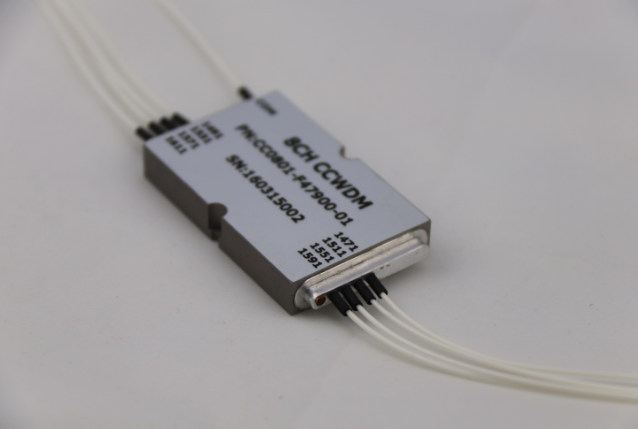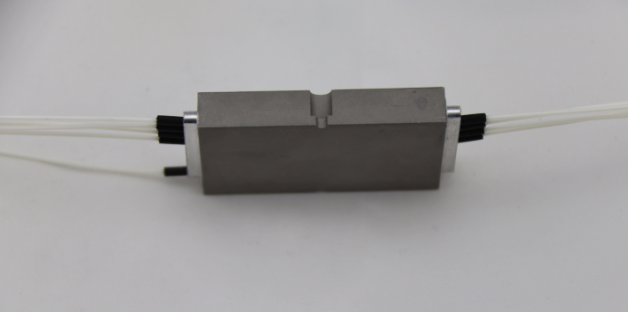CWDM system principle
CWDM is a low-cost WDM transmission technology for the access layer of the metropolitan area network. In principle, CWDM uses an optical multiplexer to multiplex optical signals of different wavelengths into a single optical fiber for transmission. At the receiving end of the link, the mixed signal in the optical fiber is decomposed into different wavelengths by means of an optical demultiplexer. Signal, connect to the corresponding receiving device. The principle is shown in Figure 1. The main difference from DWDM is: Compared with the 0.2nm to 1.2nm wavelength interval in the DWDM system, CWDM has a wider wavelength interval, and the industry standard wavelength interval is 20nm. The wavelength specified by ITU-T G.694.2 is shown in Table 1. The band to which each wavelength belongs is shown in Figure 2, covering the five bands of O, E, S, C, and L of the single-mode fiber system.

Due to the wide wavelength interval of the CWDM system, the requirements for the technical indicators of the laser are relatively low. Since the wavelength interval reaches 20nm, the maximum wavelength shift of the system can reach -6.5℃~+6.5℃, and the emission wavelength accuracy of the laser can be relaxed to ±3nm, and in the working temperature range (-5℃~70℃), the temperature The wavelength drift caused by the change is still within the allowable range, and the laser does not need a temperature control mechanism, so the structure of the laser is greatly simplified and the yield is improved.
In addition, the larger wavelength interval means that the structure of the optical multiplexer/demultiplexer is greatly simplified. For example, the number of coating layers of the filter of the CWDM system can be reduced to about 50 layers, while the number of coating layers of the 100GHz filter in the DWDM system is about 150 layers, which leads to higher yields, lower costs, and greatly increases the number of filter suppliers. Conducive to competition. The cost of CWDM filter is more than 50% less than that of DWDM filter, and it will be further reduced with the increase of automated production technology and batch size.
Advantages of folding CWDM system
The most important advantage of CWDM is the low cost of equipment. The specific situation has been introduced before. In addition, another advantage of CWDM is that it can reduce the operating cost of the network. Due to the small size, low power consumption, easy maintenance and convenient power supply of CWDM equipment, 220V AC power supply can be used. Because of its small number of wavelengths, the amount of board backup is small. CWDM equipment using 8-wavelength has no special requirements for optical fibers. G.652, G.653, and G.655 optical fibers can be used, and existing optical cables can be used. CWDM system can significantly increase the transmission capacity of optical fiber and improve the utilization of optical fiber resources. The construction of metropolitan area networks is faced with a certain degree of shortage of optical fiber resources or the expensive price of leased optical fiber. The current typical coarse wavelength division multiplexing system can provide 8 optical channels, and up to 18 optical channels according to the ITU-T G.694.2 specification. Another advantage of CWDM is its small size and low power consumption. The laser of the CWDM system does not require a semiconductor cooler and temperature control function, so it can significantly reduce the power consumption. For example, each laser of the DWDM system consumes about 4W of power, while the CWDM laser without a cooler consumes only 0.5W of power. The simplified laser module in the CWDM system reduces the volume of the integrated optical transceiver module, and the simplification of the equipment structure also reduces the volume of the equipment and saves room space. Compared with the traditional TDM method, CWDM has speed and protocol transparency, which makes it more suitable for the development of high-speed data services in the metropolitan area network. There are many services with different protocols and different speeds in the metropolitan area network. CWDM provides a transmission channel that provides different speeds on a fiber and is transparent to the protocol, such as Ethernet, ATM, POS, SDH, etc., and CWDM is transparent The flexibility and add/drop multiplexing function allows users to directly add and drop a certain wavelength without changing the format of the original signal. In other words, the optical layer provides a transport structure independent of the service layer. CWDM has good flexibility and scalability. For the metropolitan area business, the flexibility of business provision, especially the speed of business provision and the ability to expand with business development, is very important. The use of CWDM technology can open services for users within one day or a few hours, and as the business volume increases, the capacity can be expanded by inserting new OTU boards. Improve the quality of business. The application of the CWDM system in the metropolitan area network can make it possible to restore the optical layer. Optical layer restoration is much more economical than electrical layer restoration. Taking into account that the optical layer recovery is independent of services and speeds, some systems that have no protection functions in their own systems (such as Gigabit Ethernet) can be protected by CWDM. Because of the above-mentioned advantages of CWDM technology, CWDM is being used more and more in fields such as telecommunications, broadcasting and television, enterprise networks, and campus networks.

The shortcomings of folding CWDM products
The biggest problem of CWDM technology is that its cost advantage relative to DWDM equipment is still not obvious enough. Optical transceiver modules and optical devices are the key to reducing costs. However, due to the small market size and small supplier shipments, the device cost advantage is not obvious. Another way to reduce costs is to simplify equipment functions, and this method leads to a decrease in the reliability and manageability of the system. DWDM products with decreasing prices also put great pressure on CWDM technology, and using DWDM technology can form a complete metro DWDM network, so the scalability is good, and the pressure on CWDM is relatively high. The number of optical channels (wavelengths) supported by the current CWDM equipment does not exceed 8, mainly because the manufacturing process of the E-band optical transceiver module is not mature. In addition, the G.652C optical cable that eliminates the water absorption peak is rarely used in the current network. , So there is not much market demand for E-band optical transceiver modules. CWDM systems with higher speeds and longer transmission distances still have many technical problems. Such as the dispersion problem of 10G system, ultra-wideband optical amplification technology, etc. In addition, the standardization process needs to be accelerated, especially in terms of service interface functions that require the guidance of operators.
The development direction of folding CWDM
At present, one of the key factors restricting the development of CWDM products is the price of optical transceiver modules and multiplexing and demultiplexing devices. With the development of the market and the progress of manufacturing technology, further reducing equipment costs is an important development direction. Develop E-band optical device technology to make it mature as soon as possible. Develop 10G rate optical channel technology to improve the capacity and scalability of the CWDM system. Supporting various service interfaces is the development direction of CWDM. The demand for multi-service interfaces at the access layer of the metropolitan area network is the driving force for manufacturers to further develop multi-service interfaces. CWDM equipment will provide multiple service interfaces such as FE, GE, SDH, ESCON, and FC. Another development direction is to be combined with MSTP or high-performance routing and switching equipment as a means to expand the line-side capacity of MSTP equipment or high-speed routers. Providing multi-level optical layer and service layer protection functions is also a development direction to meet the needs of different customers. Network management technology and equipment security and reliability have been further improved to increase their competitiveness in the market. For the newly launched G.652C optical fiber, since the price of G.652C optical cable is twice that of G.652B, and the E-band CWDM optical transceiver module technology is not yet mature, full-band CWDM will be applied in the short term (1-2 years) The possibility of equipment is not large, and the use of G.652C optical cable has the problem of large investment and no benefit in the short term, so the application of G.652C optical fiber in the metro user optical cable network is subject to certain restrictions.
Contact: Andy Huang
Phone: 0086-755-89239407
E-mail: sales@beskco.com
Add: No.3106,Longgang Avenue,Pidi Town, Longgang District, Shenzhen China
We chat